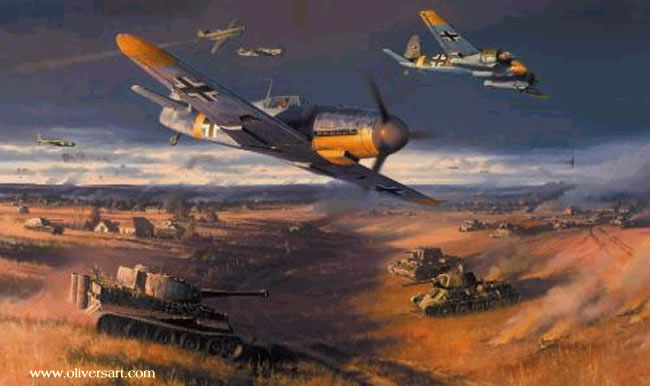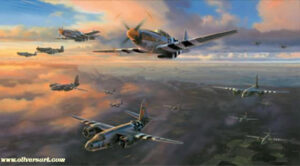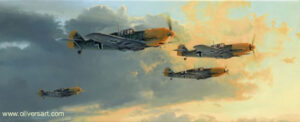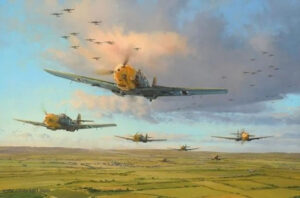Description
In July 1943 two huge armies clashed on the rolling steppes around the town of Kursk, 300 miles south of Moscow. The Germans had launched Operation ‘Citadel’ to try and regain the initiative on the Eastern Front. It was to be an encounter of epic proportions – the largest tank battle in history.
The Germans launched their attack on the Kursk salient on 5 July 1943, and for both sides this was ‘maximum effort’. The Soviets however, informed by intelligence of the impending German attack, had ample time to prepare huge defensive works with hundreds of planned anti-tank belts. They deployed 10 Tank Corps, 5 Tank Armies, 1 Mechanised Corps and 14 Field Armies equipped with 4000 anti tank guns and 6000 tanks. The Soviet Air Forces were equally impressive – 2600 aircraft. The Germans, outnumbered in every department, were forced to scrape together whatever serviceable tanks they could from their badly under-strength Panzer formations. Most of the tanks deployed were old Panzer III or IV’s, with only 147 Tigers available for action.
The northern German attack made very little headway but, in the south , the Germans had grouped all of the Panzer forces into the II SS Panzer Corps and these units, despite the enormous Soviet forces ranged against them, began to smash their way through Soviet defences.
The Luftwaffe too had brought together 1200 aircraft and these made an immediate impact on the fighting – on the first day alone German fighters broke up massive formations of Soviet aircraft, over 400 victories being claimed.
On 8 July the Soviets counter-attacked against the II SS Panzer Corps and it is this action that Nicolas Trudgian has magnificently captured in his dramatic, and highly detailed, latest painting. A Tiger and other elements of the 2nd SS Panzer Division ‘Das Reich’ clash with Soviet armour, while overhead the Luftwaffe attack at very low level. The Me109Gs of JG52 find themselves in the midst of this fiery cauldron providing close cover for the Luftwaffe anti-tank aircraft – in this case the Henshel 129s of SchG1 armed with heavy 30mm cannon to hunt the Soviet armour. By the end of the day’s fighting the Soviet III Mechanised Corps had been virtually destroyed.
This was only the beginning however, and for another five days the opposing sides clashed at close quarters, but the Soviets withstood the violent onslaught to take the initiative. For the Germans it was the beginning of an agonising retreat that ultimately would end in defeat amongst the burning ruins of Berlin two years later.
Overall print size 33″ x 23″
The Kursk Edition (Secondary Market)
Every print in the special KURSK EDITION is individually signed in pencil by two Luftwaffe fighter Aces who flew on the Eastern Front during World War II.
Feldwebel HEINZ RADLAUER
Feldwebel ERICH BRUNOTTE
Also signed by a Me109 pilot and 2 tank commanders, making a total FIVE signatures. This edition may be the last opportunity to acquire prints signed by veterans from some of the greatest tank battles in history.
SS-Sturmmann ERNST KUFNER
Unteroffizier JOHANNES OESTERHELT
SS-Oberscharführer WERNER WENDT
Kursk Edition size – 150
The signatories
Feldwebel – Heinz Radlauer
Heinz Radlauer learnt to fly gliders in 1940 aged 17, and joined the Luftwaffe in August 1941. After fighter school, in June 1944 he was posted to join JG51 ‘Molders’ then fighting on the eastern front near Minsk, scoring his first victory in October of that year. Heinz Radlauer flew the Bf109G, the Fw190a, and at the end of the war the Fw190D, by which time he had notched up over 100 combat missions, flying his last combat mission on 30 April 1945. Credited with 15 air victories, all on the Eastern Front, he was awarded the Iron Cross 1st and 2nd Class.
Feldwebel – Erich Brunotte
Erich Brunotte was born in 1923, joined the Luftwaffe in June 1941 and started immediate pilot training. He flew on the Eastern Front with 1./Gruppe Nahaufklarungs-Geschwader 102, and later transferred to fly with IV/Jageswader 51 ‘Molders’, in the 13th Staffel. Promoted to Unteroffizier in December 1944, and Feldwebel in April 1945, he flew most marks of the Bf109, and the Fw190. His very last combat mission was in the Fw ‘Dora’ 9 on May 1945 at Flensburg in northern Germany.
SS-Sturmmann Ernst-Wilhelm Kufner
Born in January 1925, Ernst-Wilhelm Kufner joined the army on 30 April 1943, becoming a Tiger tank commander in the SS-Panzer divisions. He fought on the Western Front throughout the D-Day landings and the subsequent battle for Normandy, later at the hard-fought Battle of the Bulge, in Hungary and in Austria
Unteroffizier Johannes Oesterhelt
Born in August 1925, Johannes Oesterhelt joined the Luftwaffe in July 1943 and was one of the youngest pilots to fly with JG51 ‘Molders’. Joining IV/JG51 he flew his first combat mission in January 1945, aged 19, flying with the 13th Staffel against the advancing Russians in the area around the northern city of Danzig, and protecting the retreating German army. He flew against Russian II-2s, Yak-3s, Airacobras, and also against Russian tanks. He scored 2 confirmed air victories before the war ended.
SS-Oberscharfuhrer Werner Wendt
Born in Naugard/Pommern, today in Poland, in 1921,. He joined the military at the outbreak of war in September 1939, and served first with an SS-Artillery Regiment during the Battle of France. In August 1940 he joined the SS-Artillery Regiment Liebstandarte Adolf Hitler and fought in the YUGOSLAVIAN AND Greek campaigns. Becoming a Tiger Tank Commander, he took part in the invasion of Russia, and in 1943 fought in a Tiger at the Battle of Kursk during Operation Citadel. Later in 1943 he fought in Italy, and then in 1944 at the Battle of Normandy, followed in December of that year by the Battle of the Bulge. WernerWendt was awarded the Iron 1st & 2nd class.




